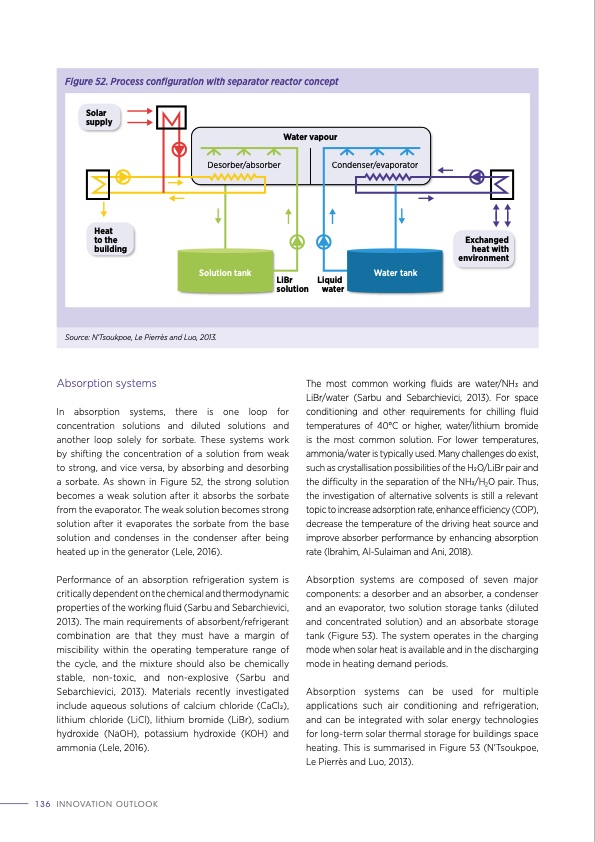
PDF Publication Title:
Text from PDF Page: 136
Figure 52. Process configuration with separator reactor concept Solar supply Heat to the building Water vapour Desorber/absorber LiBr solution Conde Liquid water r n e s b e r r/ o e s v b a a p / o r r e at b o r r oseD Exchanged heat with environment Solution tank kWnaattenroitaunlkoS Source: N’Tsoukpoe, Le Pierrès and Luo, 2013. Absorption systems In absorption systems, there is one loop for concentration solutions and diluted solutions and another loop solely for sorbate. These systems work by shifting the concentration of a solution from weak to strong, and vice versa, by absorbing and desorbing a sorbate. As shown in Figure 52, the strong solution becomes a weak solution after it absorbs the sorbate from the evaporator. The weak solution becomes strong solution after it evaporates the sorbate from the base solution and condenses in the condenser after being heated up in the generator (Lele, 2016). Performance of an absorption refrigeration system is critically dependent on the chemical and thermodynamic properties of the working fluid (Sarbu and Sebarchievici, 2013). The main requirements of absorbent/refrigerant combination are that they must have a margin of miscibility within the operating temperature range of the cycle, and the mixture should also be chemically stable, non-toxic, and non-explosive (Sarbu and Sebarchievici, 2013). Materials recently investigated include aqueous solutions of calcium chloride (CaCl2), lithium chloride (LiCl), lithium bromide (LiBr), sodium hydroxide (NaOH), potassium hydroxide (KOH) and ammonia (Lele, 2016). The most common working fluids are water/NH3 and LiBr/water (Sarbu and Sebarchievici, 2013). For space conditioning and other requirements for chilling fluid temperatures of 40°C or higher, water/lithium bromide is the most common solution. For lower temperatures, ammonia/water is typically used. Many challenges do exist, such as crystallisation possibilities of the H2O/LiBr pair and the difficulty in the separation of the NH3/H2O pair. Thus, the investigation of alternative solvents is still a relevant topic to increase adsorption rate, enhance efficiency (COP), decrease the temperature of the driving heat source and improve absorber performance by enhancing absorption rate (Ibrahim, Al-Sulaiman and Ani, 2018). Absorption systems are composed of seven major components: a desorber and an absorber, a condenser and an evaporator, two solution storage tanks (diluted and concentrated solution) and an absorbate storage tank (Figure 53). The system operates in the charging mode when solar heat is available and in the discharging mode in heating demand periods. Absorption systems can be used for multiple applications such air conditioning and refrigeration, and can be integrated with solar energy technologies for long-term solar thermal storage for buildings space heating. This is summarised in Figure 53 (N’Tsoukpoe, Le Pierrès and Luo, 2013). 136 INNOVATION OUTLOOKPDF Image | THERMAL ENERGY STORAGE Outlook

PDF Search Title:
THERMAL ENERGY STORAGE OutlookOriginal File Name Searched:
IRENA_Innovation_Outlook_TES_2020.pdfDIY PDF Search: Google It | Yahoo | Bing
Turbine and System Plans CAD CAM: Special for this month, any plans are $10,000 for complete Cad/Cam blueprints. License is for one build. Try before you buy a production license. More Info
Waste Heat Power Technology: Organic Rankine Cycle uses waste heat to make electricity, shaft horsepower and cooling. More Info
All Turbine and System Products: Infinity Turbine ORD systems, turbine generator sets, build plans and more to use your waste heat from 30C to 100C. More Info
CO2 Phase Change Demonstrator: CO2 goes supercritical at 30 C. This is a experimental platform which you can use to demonstrate phase change with low heat. Includes integration area for small CO2 turbine, static generator, and more. This can also be used for a GTL Gas to Liquids experimental platform. More Info
Introducing the Infinity Turbine Products Infinity Turbine develops and builds systems for making power from waste heat. It also is working on innovative strategies for storing, making, and deploying energy. More Info
Need Strategy? Use our Consulting and analyst services Infinity Turbine LLC is pleased to announce its consulting and analyst services. We have worked in the renewable energy industry as a researcher, developing sales and markets, along with may inventions and innovations. More Info
Made in USA with Global Energy Millennial Web Engine These pages were made with the Global Energy Web PDF Engine using Filemaker (Claris) software.
Sand Battery Sand and Paraffin for TES Thermo Energy Storage More Info
| CONTACT TEL: 608-238-6001 Email: greg@infinityturbine.com | RSS | AMP |